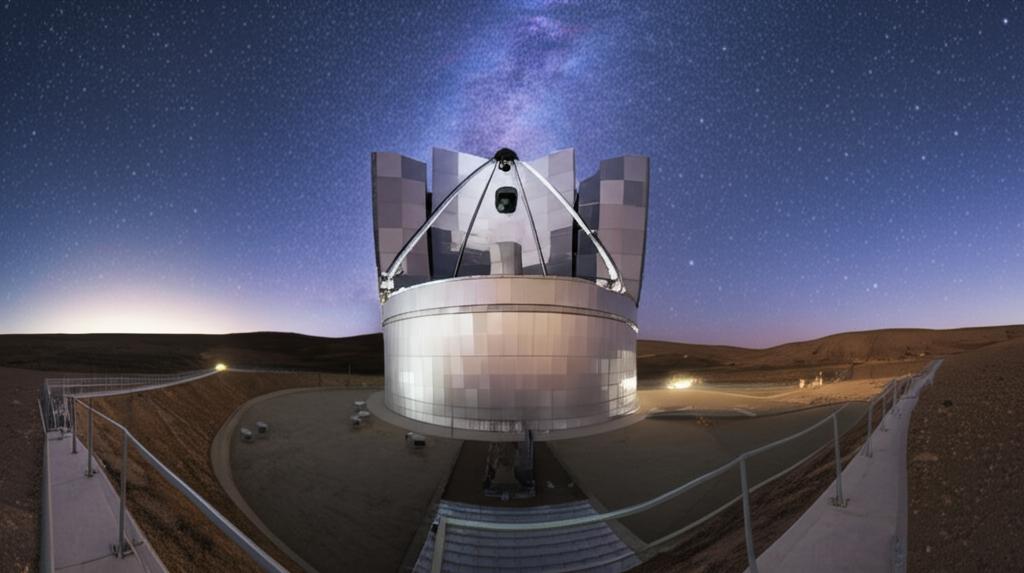Astronomical observatories have a rich history, evolving from simple platforms for naked-eye observation to sophisticated, technologically advanced facilities. Early observatories, some dating back to prehistoric times like Stonehenge, were often used for calendrical and religious purposes, tracking the movements of celestial bodies. The invention of the telescope in the early 17th century revolutionized astronomy, leading to the development of observatories with increasingly powerful instruments. Initially private endeavors, often supported by rulers interested in improved navigation, observatories gradually transitioned into state-funded institutions dedicated to scientific research. The design of observatories also evolved, from single buildings housing all instruments to a collection of specialized structures, each optimized for specific functions.
The Vera C. Rubin Observatory, currently nearing completion on Cerro Pachón in Chile, represents a significant leap in this evolution and is poised to revolutionize our understanding of the universe. Formerly known as the Large Synoptic Survey Telescope (LSST), the observatory is named in honor of Vera C. Rubin, an American astronomer who made groundbreaking discoveries about galaxy rotation rates, providing key evidence for the existence of dark matter. The telescope itself is named the Simonyi Survey Telescope, recognizing a significant private donation.
The Legacy Survey of Space and Time (LSST)Rubin Observatory's primary mission is to conduct the Legacy Survey of Space and Time (LSST), a decade-long survey of the southern sky. This ambitious project will repeatedly scan the sky every few nights, capturing an unprecedented amount of data and creating a detailed, time-lapse movie of the observable universe. The LSST is designed to address four primary science areas:
- Probing Dark Energy and Dark Matter: By mapping billions of galaxies and observing phenomena like Type Ia supernovae and weak gravitational lensing, Rubin will provide new insights into the nature of dark energy, the mysterious force driving the accelerating expansion of the universe, and dark matter, which makes up the vast majority of matter in the cosmos.
- Taking an Inventory of the Solar System: The survey will discover and track millions of new asteroids, comets, and other small bodies in our solar system, including potentially hazardous asteroids. This data will significantly improve our understanding of solar system formation and evolution.
- Exploring the Transient Optical Sky: Rubin will detect and monitor a vast number of transient events – objects that change in brightness or position over time, such as exploding stars (supernovae), outbursts from black holes, and variable stars. It is expected to issue up to 10 million alerts per night, notifying the global astronomical community of these changes in near real-time.
- Mapping the Milky Way: The LSST will provide a detailed map of our own galaxy, revealing its structure, formation history, and the distribution of stars within it.
The Vera C. Rubin Observatory incorporates several groundbreaking technologies:
- The Simonyi Survey Telescope: This 8.4-meter telescope features a unique three-mirror anastigmat design. This compact design provides an exceptionally wide field of view (3.5 degrees, or 9.6 square degrees), allowing it to survey large swathes of the sky quickly. The primary mirror (M1) is 8.4 meters in diameter, the secondary mirror (M2) is 3.4 meters, and the tertiary mirror (M3), located within the primary, is 5.0 meters.
- The LSST Camera: At the heart of the observatory is the world's largest digital camera ever constructed for astronomy. Roughly the size of a small car and weighing nearly 2,800 kg (6,200 lbs), this 3.2-gigapixel camera is equipped with 189 charge-coupled device (CCD) sensors. It features an automated filter-changing system with six filters (u,g,r,i,z, and y) covering wavelengths from 320 to 1060 nm. The installation of this massive camera onto the telescope was a major milestone achieved in March 2025.
- Data Handling: Rubin Observatory will generate an enormous amount of data – approximately 20 terabytes per night. Over its ten-year survey, it will produce a raw data archive of about 60 petabytes and a catalog database of around 15 petabytes. Dedicated computer facilities will process this data in real-time. Data products will be made widely accessible to the scientific community and the public, fostering a new era of "big data" astronomy.
- Auxiliary Telescope: A smaller, 1.2-meter Auxiliary Telescope will operate alongside the main Simonyi Survey Telescope. Its purpose is to measure how starlight is affected by the Earth's atmosphere, allowing for more accurate calibration of the LSST data.
As of May 2025, the Vera C. Rubin Observatory is in its final stages of construction and commissioning. The LSST Camera was successfully installed on the telescope in March 2025. First on-sky observations with an engineering camera occurred in October 2024. System first light is anticipated in July 2025, with full survey operations expected to commence later in 2025.
The scientific impact of the Rubin Observatory is expected to be transformative. It will lead to the discovery of tens of billions of stars and galaxies and millions of solar system objects. The sheer volume and depth of the LSST data will enable astronomers to address fundamental questions about the universe in new ways and will undoubtedly lead to unexpected discoveries. The project is already inspiring new approaches to data analysis and collaboration within the astronomical community. The observatory is a joint initiative of the U.S. National Science Foundation (NSF) and the U.S. Department of Energy (DOE) Office of Science, operated jointly by NSF's NOIRLab and DOE's SLAC National Accelerator Laboratory.
The Vera C. Rubin Observatory stands as a testament to the continued evolution of astronomical observatories, pushing the boundaries of technology and our ability to explore the cosmos. Its decade-long survey will provide an unparalleled dataset that will shape astronomical research for decades to come.

